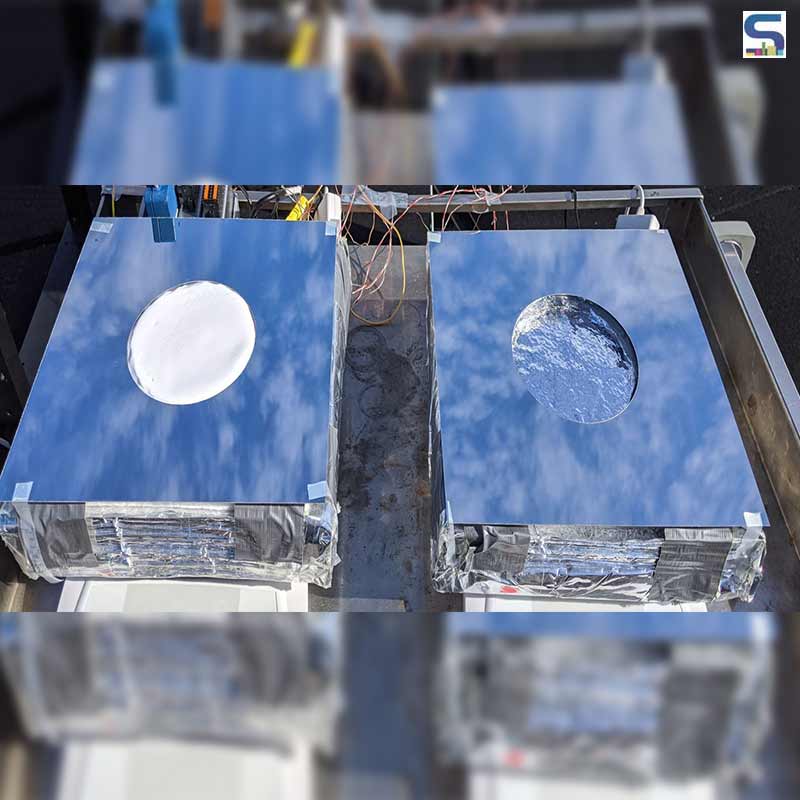
Climate change is making the planet warmer. This has thus increased the usage of power-hungry air conditioning systems, thereby stressing existing power grids and bypassing many locations with little or no reliable electric power. A team of researchers at the Massachusetts Institute of Technology (MIT) has come up with an innovative system that offers a way to use passive cooling to preserve food crops and supplement conventional air conditioners in buildings without using power. Here is a detailed report on SURFACES REPORTER (SR).
The recent innovation developed by MIT researchers combines radiative cooling, evaporative cooling, and thermal insulation in a slim package that resembles existing solar panels. Reportedly, it can provide nearly 19 degrees Fahrenheit (9.3 degrees Celsius) of cooling from the ambient temperature, which is sufficient for safe food storage for about 40 per cent longer under very humid conditions. The system not only uses passive cooling to preserve food crops but also supplements conventional air conditioners in buildings with only a small need for water and no need for power.
Prototype
In a paper by MIT postdoc Zhengmao Lu, Arny Leroy PhD ’21, professors Jeffrey Grossman and Evelyn Wang, and two others, the findings have been reported in the journal Cell Reports Physical Science. The research team includes Lenan Zhang of MIT’s Department of Mechanical Engineering and Jatin Patil of the Department of Materials Science and Engineering. Additionally, the team has been partly supported by MIT’s Abdul Latif Jameel Water and Food Systems Lab. The researchers claim that such a system will reportedly meet the cooling needs where there is a lack of electricity and water.
The prototype has been placed in a small area on the MIT campus’s rooftop. The outcome of the prototype was that in direct sunlight, the cooling device cooled the area beneath the panel to 9.3 degrees Celsius, below ambient temperature. The prototype applies the known principles of evaporative and radiative cooling where the former uses evaporated water to cool hot air while the latter, unlike air conditioners that emit heat directly to outer space rather than the surrounding environment.
Design and materials
Bifurcated into three layers of materials, where the top layer is an aerogel – a material that comprises air enclosed in the cavities of a sponge-like polyethylene-made structure. Despite the material being highly insulating, it freely allows water vapour and infrared radiation to pass through. The water evaporation provides cooling while the infrared radiation radiates some of the heat straight up through the air and space, unlike conventional air conditioners that spew hot air into the surrounding.
Right below the aerogel layer is a layer of hydrogel, which is another sponge-like material whose pores are filled with water. The material is quite similar to the ones that are commercially used for products such as cooling pads or wound dressings. Water vapour forms at the surface of the hydrogel layer where it provides the water source for evaporative cooling by passing up the vapour through the aerogel layer and out to the environment. Under the hydrogel layer is a mirror-like layer that reflects any incoming sunlight, ricocheting it through the device rather than letting it heat the materials, thereby reducing their thermal load. Being a good insulator, the top layer of aerogel is also highly solar-reflecting and limits the amount of solar heating of the device even under strong direct sunlight.
The prototype resembles a conventional solar panel. However, instead of generating electricity, it provides direct cooling by acting as a roof of a food storage container and/or sending chilled water through pipes to cool parts of an existing air conditioning system and improve its efficiency. Reportedly, as per the team, the only maintenance the device requires is of adding water for evaporation. Since the consumption is low, in the hottest and driest areas, water needs to be added once every four days while in wetter areas, only once a month.
Challenges
According to Lu, previously the challenge was that the evaporative materials often do not deal with solar absorption well. Initially these materials when are under the sun, they tend to get heated. This makes them unable to achieve a high cooling power at the ambient temperature. Also, aerogel material, which is a key to the system’s overall efficiency, is expensive to produce and requires special equipment for critical point drying (CPD) to remove solvents slowly from the delicate porous structure without damaging it.
Currently, the team is exploring ways of either making this drying process more inexpensive, such as by using freeze-drying, or finding alternative materials that can provide the same insulating function at a lower cost, such as membranes separated by an air gap.
Image credits: MIT